Island-Hopping in Tahiti and French Polynesia

Text and Photography by Stephen Frink
Picture paradise: Verdant peaks towering over turquoise lagoons. Remote and vast white sand beaches. Tahiti is a dive destination like no other, offering the epitome of tropical beauty above and a compelling marine ecosystem below. And for big critter enthusiasts searching for sharks, mantas and even whales, these islands boast a diversity of predators and pelagics.
Tahiti is actually the largest island in French Polynesia — a vast territory of 118 islands clustered in five separate archipelagoes and spread across more than a million square miles in the South Pacific — but has also become the name by which all the islands are known. They range from towering volcanic peaks to small atolls, and the diving is similarly varied, with options that range from shark-filled passes to shallow reefs to deep vertical walls. Divers can experience the islands from land-based resorts or from the live-aboards that ply these waters.
A few years ago, I visited Tahiti aboard the Tahiti Aggressor — which has since been relocated — and the memory of that trip made me eager to return. This time, I combined both live-aboard (on the sailing vessel Star Flyer) and land-based diving.
With itineraries to two of the island groups, the Society Islands and the Tuamotu Atolls, the Star Flyer visits the heart of some of the very best dive sites Tahiti offers, plus offers a number of topside tours. On my trip, however, the Star Flyer itinerary was to the Society Islands only, so I planned some land-based diving in the Tuamotus. Want to experience more in these islands? You can also experience whale and shark encounters in two other, more remote archipelagoes, the Australs and Marquesas.
The Society Islands
The six main islands, including Tahiti, that make up this fabled group rise steeply out of the sea, and offer excellent diving on both the inner and outer sides of their lagoons.
Tahiti Papeete is the jumping-off point for both live-aboard and land-based diving in the islands. The capital city is cosmopolitan and thrums with French and South Pacific cultural influences. Despite its charms, I'm not sure if its underwater attractions are commensurate--urbanity and quality diving are often mutually exclusive. But at Shark Valley, 10 minutes from Papeete's main pass, I actually see the best coral reef I experience while in the Society Islands. Antler and boulder corals are washed by bright blue water, and as is typical of so many dives here, there are lots of sharks. Grays and black-tips dominate the shark feed (most of the shark dives in the islands are feeding encounters), but not before some very large and bold triggerfish take their share.
We also dive a World War II wooden minesweeper, the Cargo Ship, along a sandy slope in Faa'a Lagoon, in only 20 to 55 feet of water. The ship was converted to a schooner and used to ferry passengers and freight between the islands before being intentionally sunk in 1967. Today, the superstructure has collapsed, but it's a great place for fish-watching. A twin-engine Catalina seaplane is nearby, and offers easy access through its right-side cargo door.
Bora Bora Magnificent beaches and luxury resorts have made this island hugely popular among tourists. Divers love it too: A wide lagoon encircles Bora Bora, with dives sites peppered on both sides of it. Tapu is a must-do dive. Along a gently sloping reef of boulder and antler corals, the stars of the show are the black-tip reef sharks and lemon sharks. From their social behavior, they're obviously accustomed to being fed. The 7-foot lemons are particularly impressive, with their underslung jaws and raggedly protruding teeth. The resulting riot of action includes colorful snapper and butterflyfish darting in to grab whatever bits of bait they can--careful to avoid being bait themselves--as the big bruising lemons burst through at will.
We also visit a site called Muri Muri, a bit farther from the lagoon entrance, with 120 feet of visibility and corals in vibrant hues. Our highlights here are omnipresent gray reef sharks and a turtle who grazes on bits of algae-covered antler corals, completely oblivious to us.
Raiatea & Taha'a Topside, the pace on these twin islands--which share a lagoon--is more relaxed than others in the chain. Raiatea and Taha'a also have an engaging seascape in common. Numerous seamounts, caverns and grottoes punctuate the sides of the reef.
Off the northwestern side of Raiatea, Miri Miri is a gently sloping reef in calm, clear water that's protected from swell and current. The site is also known as Napoleons of Miri Miri and The Roses because of its resident giant Napoleon wrasses (which are fed by local divemasters) and fields of Montipora coral, resembling a carpet of roses.
The 100-year-old Nordby, one of the few wrecks in Tahiti, is off Raiatea's eastern coast. She's a three-masted, iron-hulled Danish merchant vessel that sank in 1900 during a storm, and is relatively well preserved. You can explore both its interior and exterior, where you'll find the anchor, chain, two main masts and rudder. Lots of fish, including Moorish idols, angelfish and lionfish, shelter here.
It's also possible to snorkel in the channel between two motus (small islands) near Taha'a. This particular drift among the scattered coral heads that rise to within inches of the surface is impressive.
Moorea This island's topside beauty is matched by its underwater topography of coral canyons and valleys, but the name of the game here is sharks. While the Star Flyer crew arranges a single-tank dive excursion, a local land-based dive guide sets up a thoroughly enjoyable shark-feeding dive at a site called Tiki, followed by a very impressive lemon shark feeding at a site called The Canyons, near Oponohu Bay.
Expect better than 100-foot visibility at Tiki, with schools of blue-lined snapper, bigeye and cardinalfish along the hard coral slope. There are plenty of sharks too, even without bait. You'll mostly see gray reef sharks and black-tips, but occasionally a lemon shark appears. The sharks tend to cruise rather lethargically until a crewmember drops a wire cage full of bait over the side of the boat. The scent of the bait in the water beckons butterflyfish, triggerfish and snappers, all trying for any bit of bait that protrudes from the cage. Even for those jaded by shark feeds, this one is special because of the schools of colorful tropicals and the two different species of sharks that are pretty much guaranteed to appear.
There are several terrific snorkel sites on Moorea. One is located between two motus, in a clear channel punctuated by shallow coral heads and another is a shallow sand plateau reminiscent of Grand Cayman's famed Sandbar. In both spots stingrays hustle for their share of the proffered bait, and on the sandbar, black-tip reef sharks also show up.
Huahine Laid-back Huahine has diving for all skill levels in a quiet lagoon, an outer reef and current-swept but manageable passes. During an outgoing current, sharks, barracuda and other predators patrol Avapeihi Pass in search of drifting fish. At about 50 feet, the reef forms a plateau that slopes down to a sandy bottom at about 80.
Tuamotu Atolls
These low-lying atolls are east of the Society Islands and seduce divers with their protected lagoons, exciting passes and steep drop-offs.
Rangiroa The second-largest atoll in the world--from the edge of its lagoon, it's impossible to see the opposite side--Rangiroa offers amazing drift dives.
Avatoru Pass is a magical dive. The water in the Tuamotu Atolls is so spectacularly clear that we spot six silver-tips coming from more than 100 feet away. The sharks are here for the tuna our dive guide stashes beneath a coral head. The sharks swim concentric circles around the bait, definitely interested, but not acting erratically. By pivoting at the epicenter of the action, I'm rewarded with lots of nice shark portraits, but then, after about 10 minutes, the shark wrangler amps up the action, moving the bait into the open. Dainty nibbling is not something these guys do, and once the bait is let loose, the pace accelerates. Soon, the crystalline water is cloudy with shredded tuna.
The other marquee dives in Rangiroa include an exhilarating, high velocity drift through Tiputa Pass, primarily to see the gray reef sharks that abound here. You have to dive deep, about 120 feet, to drop into the mass of sharks, but at certain times, with certain tides, there can also be several manta rays in the Pass at much shallower depths. Also, local dive guides say there are consistent two- to-seven minute encounters with wild dolphins. Divers work the blue water just off the mouth of the cut and typically the dolphins come to them. I'm 40 feet away from the pod when it makes a pass by another set of divers in our group, nearly close enough to touch.
There's also a far more sedate dive called Aquarium. Lovely scattered coral heads host large schools of snapper and moray eels, and once a bit of bread or bait hits the water, massive throngs of sergeant majors and butterflyfish join them.
Manihi Northeast of Rangiroa, this island is known for its black pearl production and the diving at Tairapa Pass, which channels nutrients in and out of the lagoon, attracting feeding mantas, gray and white-tip sharks, plus all sorts of smaller fish, including groupers, snappers and triggerfish. The pass is about 300 feet wide and starts at about 80 feet on the ocean side and gradually rises to a shallow coral shelf before sloping into the lagoon. You can dive the northern wall, which is sheltered from a lot of current and offers dense congregations of fish along the drop-off, cross the pass to the southern side, where you'll often encounter schools of barracuda waiting for prey, or let the current carry you into the pass during incoming tides.
Fakarava This massive atoll offers pristine diving at two passes: Garuae, at the north end, and Tumakohua, at the south end. This is wilderness diving that packs a mighty wallop. At more than 2,500 feet across, Garuae is the largest pass in Tahiti. Most dives are done as drifts on the incoming current. You start on the ocean side and then the powerful current pushes you--and thousands of fish--into the channel. You'll also find vast expanses of corals here.
Our Thanks
Star Flyer
starclippers.com
Tahiti Tourism
tahiti-tourisme.com
Top Dive
topdive.com
Bathys Diving Moorea & Tahiti
bathys-diving.com
The Six Passengers
the6passengers.com
Tahiti Resources
Tahiti Tourism • tahiti-tourisme.com • 877-GO-TAHITI
Caradonna Dive Adventures • caradonna.com • 800-328-2288
Trip-N-Tour • trip-n-tour.com • 800-348-0842
Topside Island Tours
Visit the web sites listed below, tahiti-tourisme.com and starclippers.com for more details on these topside activities.
Papeete, Tahiti Stop in at the Paul Gauguin Museum, which houses original works, documents, letters and personal belongings of the artist, who lived on Tahiti from 1891 to 1893 and again from 1895 until his death in May 1903. The Harrison W. Smith Botanical Garden is adjacent to the museum.
Moorea Visitors here have a few topside options, including a helicopter sightseeing tour, off-road safari, and lagoon cruise. thebigday.com/Travel/TahitiGuide/MooreaActivities.asp
Bora Bora Take a sightseeing tour by helicopter, parasail to the shark and ray feeding experience, or visit the lagoonarium, where you can encounter sharks, rays, turtles and parrotfish. boraboraisland.com/lagoonarium
Raiatea A four-wheel jeep safari takes guests to the heart of the island through bamboo forests, and groves of chestnut, mango and guava trees. raiatea.com/tosee/sights.html
Taha'a Take a dolphin-watching excursion or visit a vanilla plantation. raiatea.com/tosee/sights.html
Huahine Paddle a covered outrigger canoe to Motu Tefarearii islet where you can snorkel and picnic. huahine.com
Tiputa, Rangiroa Visit a black pearl farm. tahititravel.com/rangi.html
Fakarava Visit black pearl farms and idyllic white sand beaches. thetahititraveler.com/islandguide/fakaravaintro.asp
Tahiti's Wild Side
We didn't get to every corner of Tahiti, but don't let that stop you, as there's awesome big animal encounters in the Marquesas and Austral archipelagoes. Keep in mind that these islands are off the radar screen of most tourists. Check tahiti-tourisme for details on how to get to the islands and where to stay.
Nuku Hiva, Marquesas The diving in the Marquesas, the northernmost island group in Tahiti, is done off Nuku Hiva. Completely different from the islands in the other chains, Nuku Hiva is wilderness diving--it has no sheltering reefs or lagoons, and its waters are choked with plankton, which drops the vis to 30 or 40 feet, but brings in the really big boys, including scalloped hammerheads and melon-headed whales. There are a handful of small hotels and guest houses.
Rurutu, Australs Far south of Tahiti and the Society Islands, the island of Rurutu offers humpback whale encounters from July to October, when the cetaceans come to mate, calve and nurse. These are snorkel-only encounters. Like Nuku Hiva, the only accommodations are small hotels and guest houses. raiemantaclub.com/ruru-uk.htm
In Depth
Dive Conditions: Seasons are reversed. Water temps are in the high 70s in winter; mid-80s in summer. Vis averages 100 feet.
Weather: Low 80s in winter; mid-80s to low 90s in summer. The rainy season is from November to April.
Getting There: Despite the distance from North America, it's incredibly easy to get to the international gateway, Papeete (PPT), as Air Tahiti Nui offers one-stop flights from New York via Los Angeles, which don't require changing planes. Hawaiian Airlines makes nonstop flights to Papeete from Honolulu. From Papeete, Air Tahiti, French Polynesia's domestic carrier, offers flights to the outlying islands.
Entry Documents: For stays of up to one month, there are no visa requirements for citizens of the U.S., Canada or Mexico. A passport valid for six months and a return or ongoing ticket is required.
Money Matters: Local currency is the French Pacific franc (CFP), though credit cards and U.S. currency are commonly accepted. Depending on the island and resort, seven-night packages, including accommodation, breakfast and diving, range from $2,000 p.p., dbl. occ., to $4,000 p.p., dbl. occ. Departure tax is approximately $80--ask your booking agent to check if it's included in the price of your airfare.
Time: The islands are two hours behind Pacific Standard Time. During daylight saving time (April to late October), the islands are three hours behind.
Direct Dial Code: 011-689.
Language: French and Tahitian are the official languages, but English is widely spoken in the main tourist areas, restaurants, shops, hotels and resorts.
Electricity: Mostly 110 volt, 60 cycles; American appliances require an adapter.
Get More: tahiti-tourisme.com or scubadiving.com/travel/pacificandindianoceans/french_polynesia.
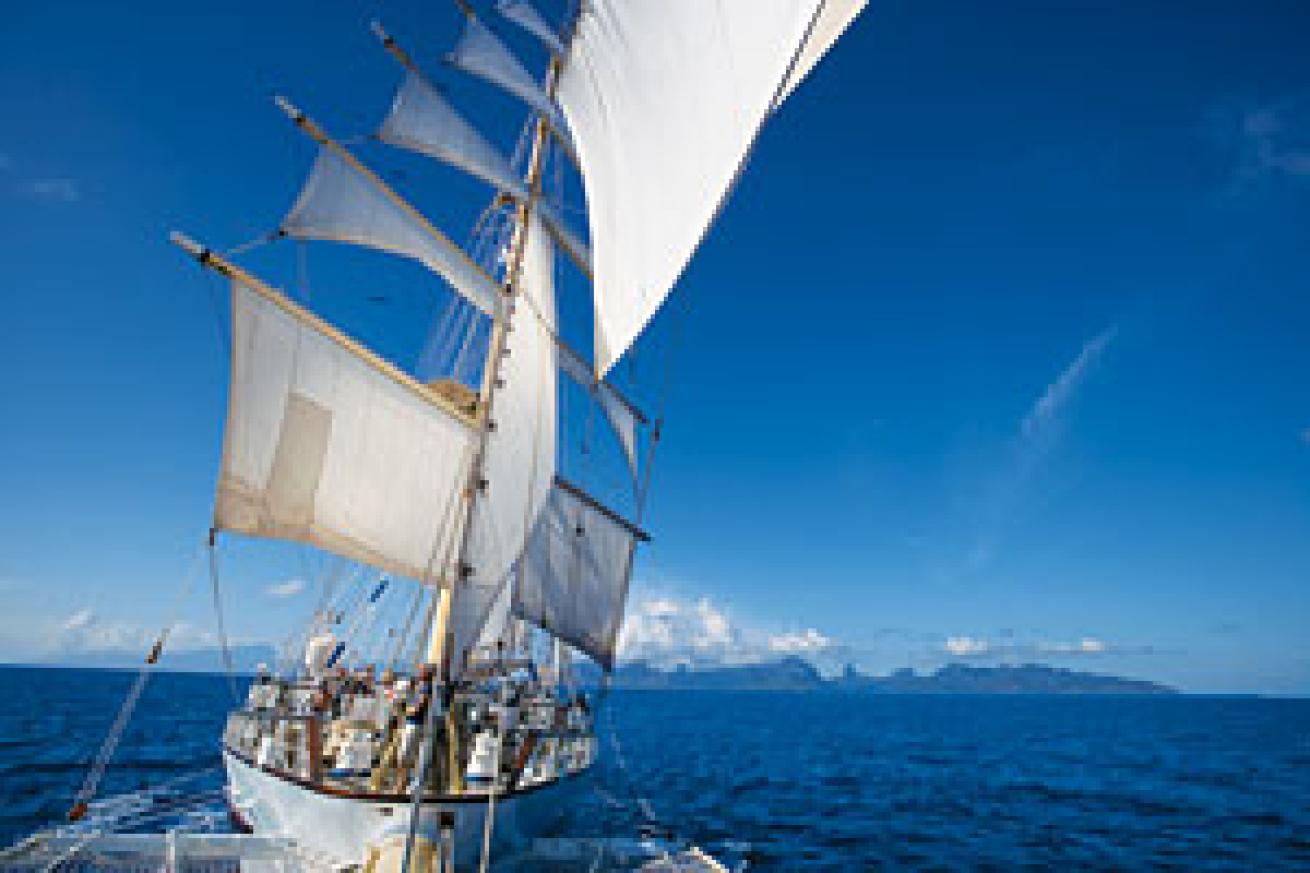
Stephen Frink
Picture paradise: Verdant peaks towering over turquoise lagoons. Remote and vast white sand beaches. Tahiti is a dive destination like no other, offering the epitome of tropical beauty above and a compelling marine ecosystem below. And for big critter enthusiasts searching for sharks, mantas and even whales, these islands boast a diversity of predators and pelagics.
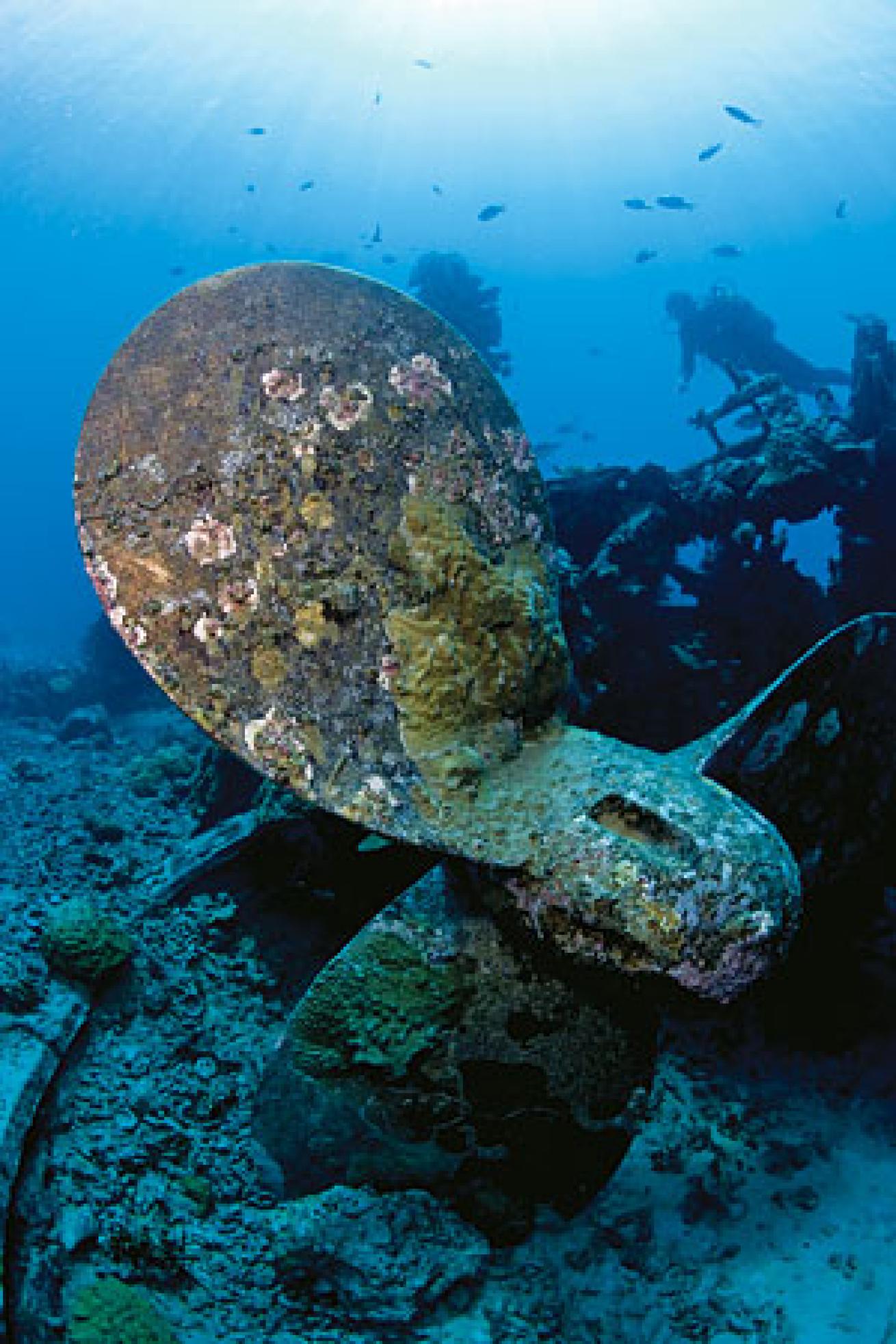
Stephen Frink
Tahiti is actually the largest island in French Polynesia — a vast territory of 118 islands clustered in five separate archipelagoes and spread across more than a million square miles in the South Pacific — but has also become the name by which all the islands are known. They range from towering volcanic peaks to small atolls, and the diving is similarly varied, with options that range from shark-filled passes to shallow reefs to deep vertical walls. Divers can experience the islands from land-based resorts or from the live-aboards that ply these waters.
Stephen Frink
A few years ago, I visited Tahiti aboard the Tahiti Aggressor — which has since been relocated — and the memory of that trip made me eager to return. This time, I combined both live-aboard (on the sailing vessel Star Flyer) and land-based diving.
With itineraries to two of the island groups, the Society Islands and the Tuamotu Atolls, the Star Flyer visits the heart of some of the very best dive sites Tahiti offers, plus offers a number of topside tours. On my trip, however, the Star Flyer itinerary was to the Society Islands only, so I planned some land-based diving in the Tuamotus. Want to experience more in these islands? You can also experience whale and shark encounters in two other, more remote archipelagoes, the Australs and Marquesas.
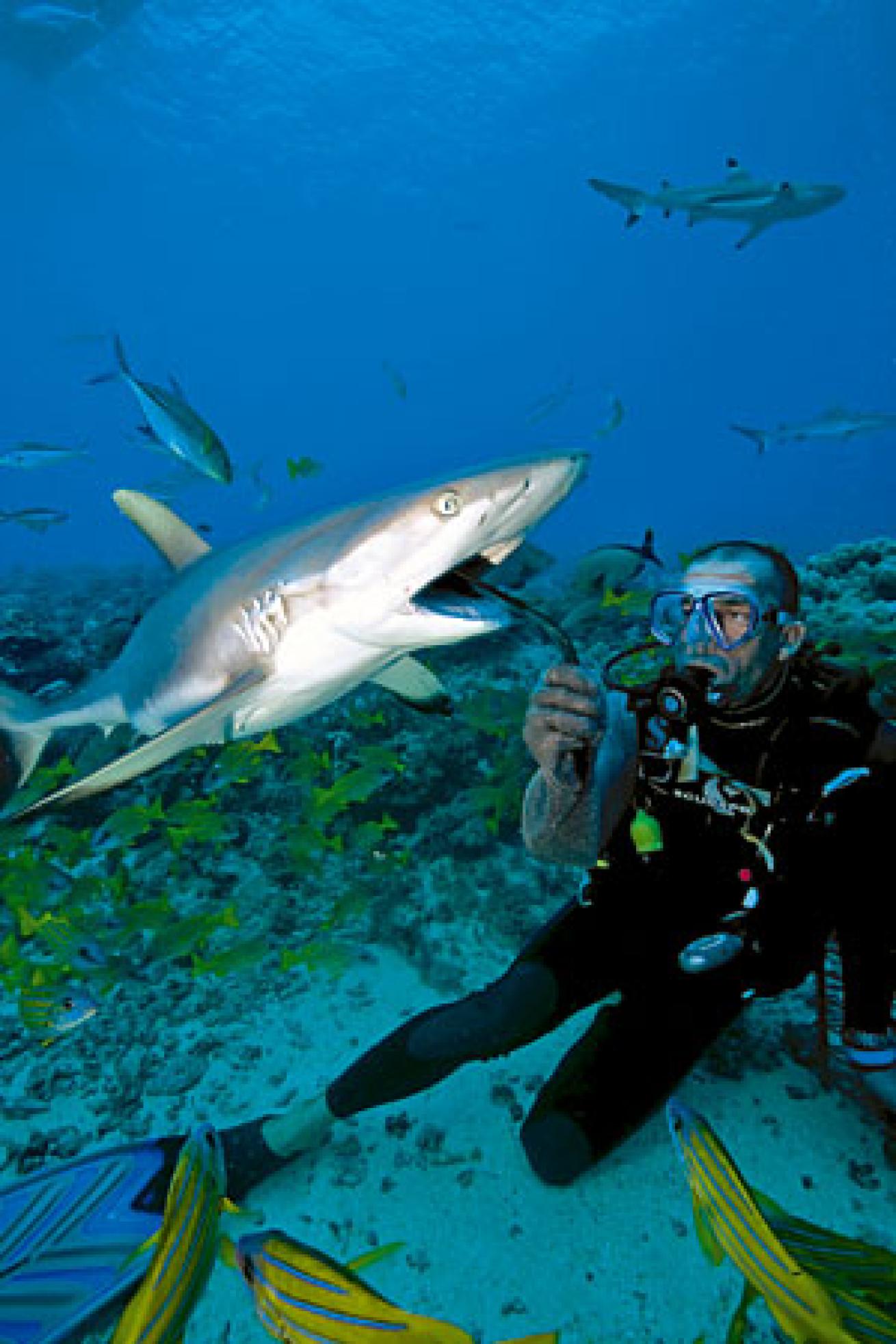
Stephen Frink
The Society Islands
The six main islands, including Tahiti, that make up this fabled group rise steeply out of the sea, and offer excellent diving on both the inner and outer sides of their lagoons.
Tahiti Papeete is the jumping-off point for both live-aboard and land-based diving in the islands. The capital city is cosmopolitan and thrums with French and South Pacific cultural influences. Despite its charms, I'm not sure if its underwater attractions are commensurate--urbanity and quality diving are often mutually exclusive. But at Shark Valley, 10 minutes from Papeete's main pass, I actually see the best coral reef I experience while in the Society Islands. Antler and boulder corals are washed by bright blue water, and as is typical of so many dives here, there are lots of sharks. Grays and black-tips dominate the shark feed (most of the shark dives in the islands are feeding encounters), but not before some very large and bold triggerfish take their share.
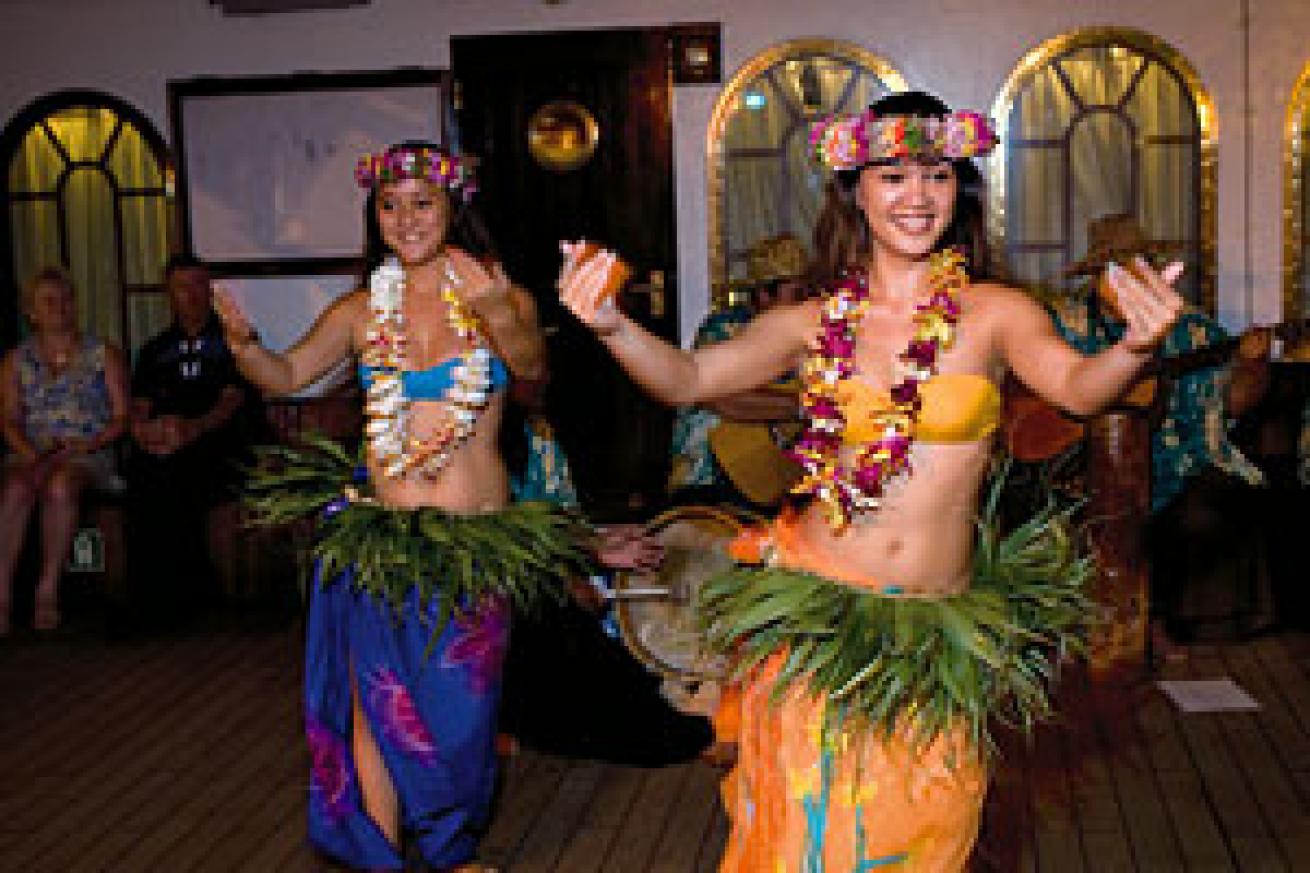
Stephen Frink
We also dive a World War II wooden minesweeper, the Cargo Ship, along a sandy slope in Faa'a Lagoon, in only 20 to 55 feet of water. The ship was converted to a schooner and used to ferry passengers and freight between the islands before being intentionally sunk in 1967. Today, the superstructure has collapsed, but it's a great place for fish-watching. A twin-engine Catalina seaplane is nearby, and offers easy access through its right-side cargo door.
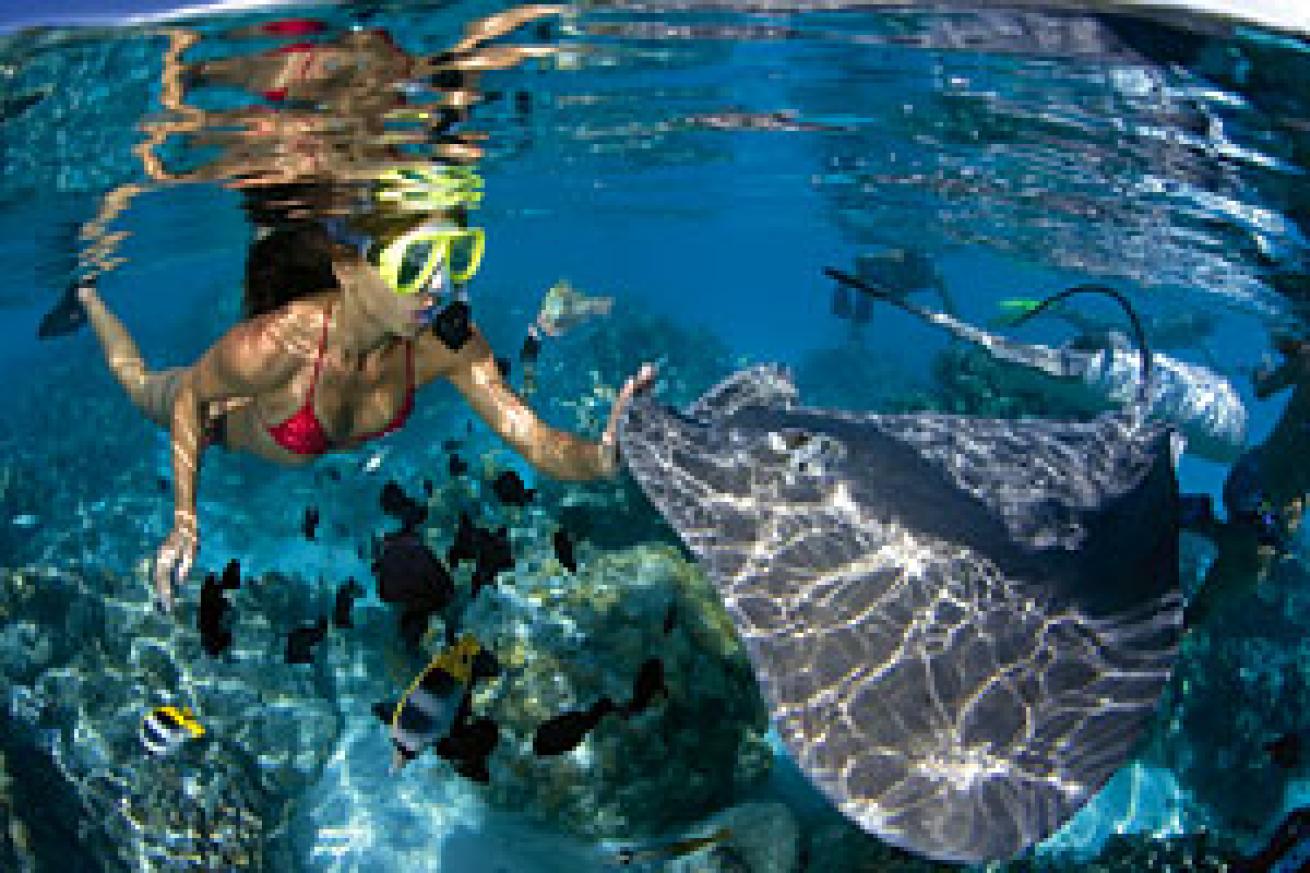
Stephen Frink
Bora Bora Magnificent beaches and luxury resorts have made this island hugely popular among tourists. Divers love it too: A wide lagoon encircles Bora Bora, with dives sites peppered on both sides of it. Tapu is a must-do dive. Along a gently sloping reef of boulder and antler corals, the stars of the show are the black-tip reef sharks and lemon sharks. From their social behavior, they're obviously accustomed to being fed. The 7-foot lemons are particularly impressive, with their underslung jaws and raggedly protruding teeth. The resulting riot of action includes colorful snapper and butterflyfish darting in to grab whatever bits of bait they can--careful to avoid being bait themselves--as the big bruising lemons burst through at will.
We also visit a site called Muri Muri, a bit farther from the lagoon entrance, with 120 feet of visibility and corals in vibrant hues. Our highlights here are omnipresent gray reef sharks and a turtle who grazes on bits of algae-covered antler corals, completely oblivious to us.
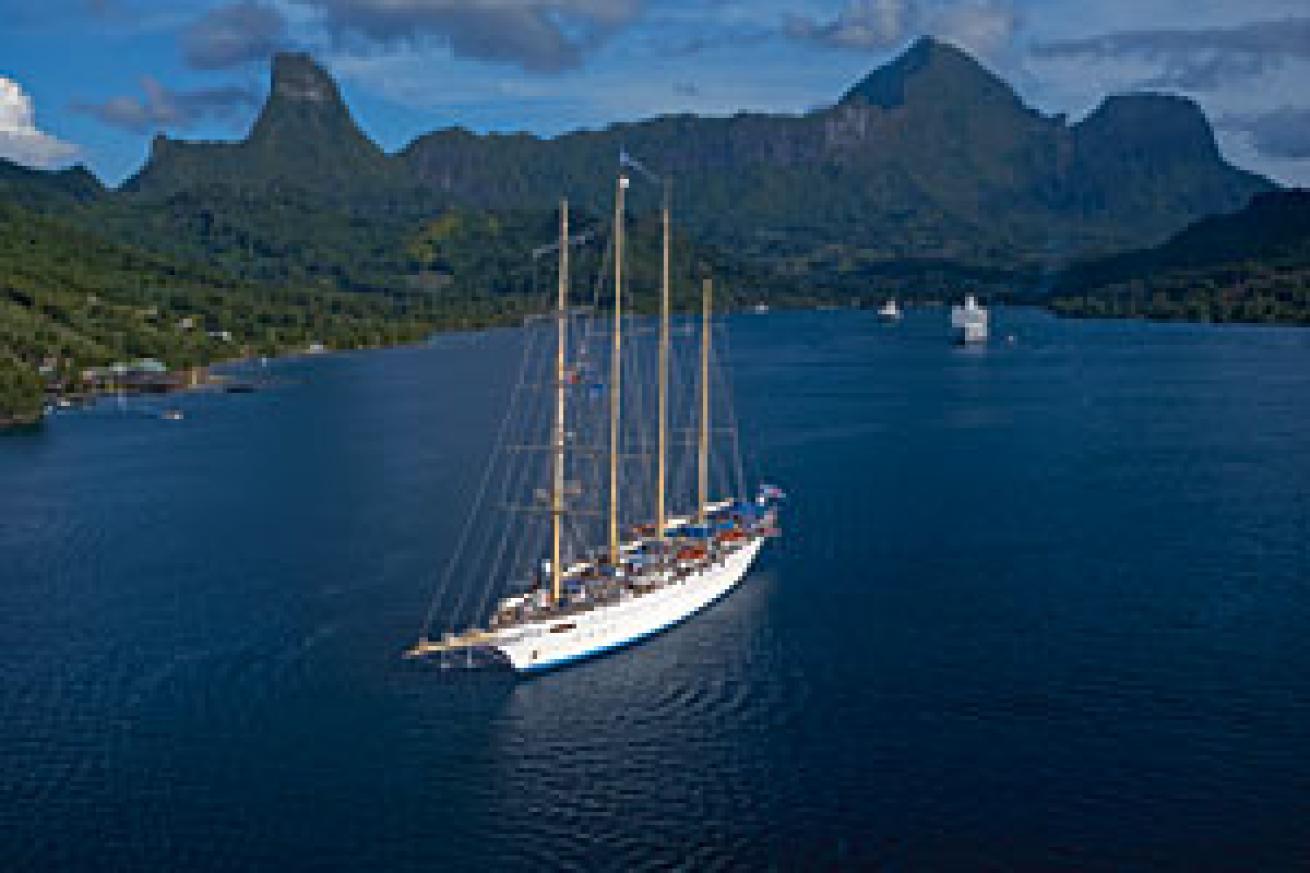
Stephen Frink
Raiatea & Taha'a Topside, the pace on these twin islands--which share a lagoon--is more relaxed than others in the chain. Raiatea and Taha'a also have an engaging seascape in common. Numerous seamounts, caverns and grottoes punctuate the sides of the reef.
Off the northwestern side of Raiatea, Miri Miri is a gently sloping reef in calm, clear water that's protected from swell and current. The site is also known as Napoleons of Miri Miri and The Roses because of its resident giant Napoleon wrasses (which are fed by local divemasters) and fields of Montipora coral, resembling a carpet of roses.
The 100-year-old Nordby, one of the few wrecks in Tahiti, is off Raiatea's eastern coast. She's a three-masted, iron-hulled Danish merchant vessel that sank in 1900 during a storm, and is relatively well preserved. You can explore both its interior and exterior, where you'll find the anchor, chain, two main masts and rudder. Lots of fish, including Moorish idols, angelfish and lionfish, shelter here.
Stephen Frink
It's also possible to snorkel in the channel between two motus (small islands) near Taha'a. This particular drift among the scattered coral heads that rise to within inches of the surface is impressive.
Moorea This island's topside beauty is matched by its underwater topography of coral canyons and valleys, but the name of the game here is sharks. While the Star Flyer crew arranges a single-tank dive excursion, a local land-based dive guide sets up a thoroughly enjoyable shark-feeding dive at a site called Tiki, followed by a very impressive lemon shark feeding at a site called The Canyons, near Oponohu Bay.

Stephen Frink
Expect better than 100-foot visibility at Tiki, with schools of blue-lined snapper, bigeye and cardinalfish along the hard coral slope. There are plenty of sharks too, even without bait. You'll mostly see gray reef sharks and black-tips, but occasionally a lemon shark appears. The sharks tend to cruise rather lethargically until a crewmember drops a wire cage full of bait over the side of the boat. The scent of the bait in the water beckons butterflyfish, triggerfish and snappers, all trying for any bit of bait that protrudes from the cage. Even for those jaded by shark feeds, this one is special because of the schools of colorful tropicals and the two different species of sharks that are pretty much guaranteed to appear.
There are several terrific snorkel sites on Moorea. One is located between two motus, in a clear channel punctuated by shallow coral heads and another is a shallow sand plateau reminiscent of Grand Cayman's famed Sandbar. In both spots stingrays hustle for their share of the proffered bait, and on the sandbar, black-tip reef sharks also show up.
Huahine Laid-back Huahine has diving for all skill levels in a quiet lagoon, an outer reef and current-swept but manageable passes. During an outgoing current, sharks, barracuda and other predators patrol Avapeihi Pass in search of drifting fish. At about 50 feet, the reef forms a plateau that slopes down to a sandy bottom at about 80.
Tuamotu Atolls
These low-lying atolls are east of the Society Islands and seduce divers with their protected lagoons, exciting passes and steep drop-offs.
Rangiroa The second-largest atoll in the world--from the edge of its lagoon, it's impossible to see the opposite side--Rangiroa offers amazing drift dives.
Avatoru Pass is a magical dive. The water in the Tuamotu Atolls is so spectacularly clear that we spot six silver-tips coming from more than 100 feet away. The sharks are here for the tuna our dive guide stashes beneath a coral head. The sharks swim concentric circles around the bait, definitely interested, but not acting erratically. By pivoting at the epicenter of the action, I'm rewarded with lots of nice shark portraits, but then, after about 10 minutes, the shark wrangler amps up the action, moving the bait into the open. Dainty nibbling is not something these guys do, and once the bait is let loose, the pace accelerates. Soon, the crystalline water is cloudy with shredded tuna.
The other marquee dives in Rangiroa include an exhilarating, high velocity drift through Tiputa Pass, primarily to see the gray reef sharks that abound here. You have to dive deep, about 120 feet, to drop into the mass of sharks, but at certain times, with certain tides, there can also be several manta rays in the Pass at much shallower depths. Also, local dive guides say there are consistent two- to-seven minute encounters with wild dolphins. Divers work the blue water just off the mouth of the cut and typically the dolphins come to them. I'm 40 feet away from the pod when it makes a pass by another set of divers in our group, nearly close enough to touch.
There's also a far more sedate dive called Aquarium. Lovely scattered coral heads host large schools of snapper and moray eels, and once a bit of bread or bait hits the water, massive throngs of sergeant majors and butterflyfish join them.
Manihi Northeast of Rangiroa, this island is known for its black pearl production and the diving at Tairapa Pass, which channels nutrients in and out of the lagoon, attracting feeding mantas, gray and white-tip sharks, plus all sorts of smaller fish, including groupers, snappers and triggerfish. The pass is about 300 feet wide and starts at about 80 feet on the ocean side and gradually rises to a shallow coral shelf before sloping into the lagoon. You can dive the northern wall, which is sheltered from a lot of current and offers dense congregations of fish along the drop-off, cross the pass to the southern side, where you'll often encounter schools of barracuda waiting for prey, or let the current carry you into the pass during incoming tides.
Fakarava This massive atoll offers pristine diving at two passes: Garuae, at the north end, and Tumakohua, at the south end. This is wilderness diving that packs a mighty wallop. At more than 2,500 feet across, Garuae is the largest pass in Tahiti. Most dives are done as drifts on the incoming current. You start on the ocean side and then the powerful current pushes you--and thousands of fish--into the channel. You'll also find vast expanses of corals here.
Our Thanks
Star Flyer
starclippers.com
Tahiti Tourism
tahiti-tourisme.com
Top Dive
topdive.com
Bathys Diving Moorea & Tahiti
bathys-diving.com
The Six Passengers
the6passengers.com
Tahiti Resources
Tahiti Tourism • tahiti-tourisme.com • 877-GO-TAHITI
Caradonna Dive Adventures • caradonna.com • 800-328-2288
Trip-N-Tour • trip-n-tour.com • 800-348-0842
Topside Island Tours
Visit the web sites listed below, tahiti-tourisme.com and starclippers.com for more details on these topside activities.
Papeete, Tahiti Stop in at the Paul Gauguin Museum, which houses original works, documents, letters and personal belongings of the artist, who lived on Tahiti from 1891 to 1893 and again from 1895 until his death in May 1903. The Harrison W. Smith Botanical Garden is adjacent to the museum.
Moorea Visitors here have a few topside options, including a helicopter sightseeing tour, off-road safari, and lagoon cruise. thebigday.com/Travel/TahitiGuide/MooreaActivities.asp
Bora Bora Take a sightseeing tour by helicopter, parasail to the shark and ray feeding experience, or visit the lagoonarium, where you can encounter sharks, rays, turtles and parrotfish. boraboraisland.com/lagoonarium
Raiatea A four-wheel jeep safari takes guests to the heart of the island through bamboo forests, and groves of chestnut, mango and guava trees. raiatea.com/tosee/sights.html
Taha'a Take a dolphin-watching excursion or visit a vanilla plantation. raiatea.com/tosee/sights.html
Huahine Paddle a covered outrigger canoe to Motu Tefarearii islet where you can snorkel and picnic. huahine.com
Tiputa, Rangiroa Visit a black pearl farm. tahititravel.com/rangi.html
Fakarava Visit black pearl farms and idyllic white sand beaches. thetahititraveler.com/islandguide/fakaravaintro.asp
Tahiti's Wild Side
We didn't get to every corner of Tahiti, but don't let that stop you, as there's awesome big animal encounters in the Marquesas and Austral archipelagoes. Keep in mind that these islands are off the radar screen of most tourists. Check tahiti-tourisme for details on how to get to the islands and where to stay.
Nuku Hiva, Marquesas The diving in the Marquesas, the northernmost island group in Tahiti, is done off Nuku Hiva. Completely different from the islands in the other chains, Nuku Hiva is wilderness diving--it has no sheltering reefs or lagoons, and its waters are choked with plankton, which drops the vis to 30 or 40 feet, but brings in the really big boys, including scalloped hammerheads and melon-headed whales. There are a handful of small hotels and guest houses.
Rurutu, Australs Far south of Tahiti and the Society Islands, the island of Rurutu offers humpback whale encounters from July to October, when the cetaceans come to mate, calve and nurse. These are snorkel-only encounters. Like Nuku Hiva, the only accommodations are small hotels and guest houses. raiemantaclub.com/ruru-uk.htm
In Depth
Dive Conditions: Seasons are reversed. Water temps are in the high 70s in winter; mid-80s in summer. Vis averages 100 feet.
Weather: Low 80s in winter; mid-80s to low 90s in summer. The rainy season is from November to April.
Getting There: Despite the distance from North America, it's incredibly easy to get to the international gateway, Papeete (PPT), as Air Tahiti Nui offers one-stop flights from New York via Los Angeles, which don't require changing planes. Hawaiian Airlines makes nonstop flights to Papeete from Honolulu. From Papeete, Air Tahiti, French Polynesia's domestic carrier, offers flights to the outlying islands.
Entry Documents: For stays of up to one month, there are no visa requirements for citizens of the U.S., Canada or Mexico. A passport valid for six months and a return or ongoing ticket is required.
Money Matters: Local currency is the French Pacific franc (CFP), though credit cards and U.S. currency are commonly accepted. Depending on the island and resort, seven-night packages, including accommodation, breakfast and diving, range from $2,000 p.p., dbl. occ., to $4,000 p.p., dbl. occ. Departure tax is approximately $80--ask your booking agent to check if it's included in the price of your airfare.
Time: The islands are two hours behind Pacific Standard Time. During daylight saving time (April to late October), the islands are three hours behind.
Direct Dial Code: 011-689.
Language: French and Tahitian are the official languages, but English is widely spoken in the main tourist areas, restaurants, shops, hotels and resorts.
Electricity: Mostly 110 volt, 60 cycles; American appliances require an adapter.
Get More: tahiti-tourisme.com or scubadiving.com/travel/pacificandindianoceans/french_polynesia.










